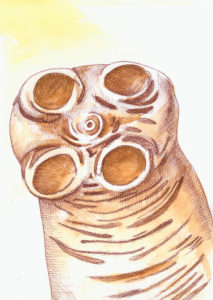 Need to diagnose an intestinal worm infection? Yeah, there’s an app for that. In fact, it’s the built-in camera app in the iPhone 4S!
Need to diagnose an intestinal worm infection? Yeah, there’s an app for that. In fact, it’s the built-in camera app in the iPhone 4S!
Dr. Isaac Bogoch, a physician specializing in infectious diseases at Toronto General Hospital, and his associates have managed to transform the iPhone 4S into a basic microscope by taping an inexpensive lens onto the phone’s camera. They were then able to tape a microscope slide (containing some stool sample from a patient) to the camera lens, back-light the slide using a small, battery-powered flashlight, and visualize the parasite eggs using the iPhone’s “zoom” function.
In side-by-side comparisons with a standard compound light microscope, the iPhone microscope was able to detect 84 percent of giant roundworm infections, 54 percent of roundworm infections, and 14 percent of hookworm infections detected by the standard microscope, the current gold standard method diagnosing worm infections. Bogoch says that “[t]here’s been a lot of tinkering in the lab with mobile phone microscopes, but this is the first time the technology has been used in the field to diagnose intestinal parasites.”
Although the microscope is not quite ready for use as the sole diagnostic test in clinical scenarios, its early success is enough to get excited about. When fully developed, mobile phone microscopes can provide clinicians with simple and portable means of diagnosis in resource-poor regions and provide scientists with a more convenient means of conducting field research in epidemiology and microbiology.
 As if one “win” against worms wasn’t enough, another group of scientists has logged a potential victory against tapeworms. Systemic cystic tapeworm diseases, such as cysticercosis and echinococcosis, are dangerous infections in humans and in livestock (in the latter, they cause $2 billion in losses per year). Fortunately, scientists Matthew Berriman, Klaus Brehm, and their colleagues have just decoded the genomes of four species of infectious tapeworm.
As if one “win” against worms wasn’t enough, another group of scientists has logged a potential victory against tapeworms. Systemic cystic tapeworm diseases, such as cysticercosis and echinococcosis, are dangerous infections in humans and in livestock (in the latter, they cause $2 billion in losses per year). Fortunately, scientists Matthew Berriman, Klaus Brehm, and their colleagues have just decoded the genomes of four species of infectious tapeworm.
The resulting genome maps have enabled these enterprising scientists to scan for currently available drugs that might be better than the most common treatments for tapeworm infections. Their goal is to find promising, already-existing drugs because doing so will save time needed for research, development, and approval of brand-new drugs. The group has already found a few candidate drugs, mostly anticancer and antivirus medicines, that might fit the bill; and Dr. Brehm is already at work testing these drugs against tapeworms.
It’s been a good week in the fight against infectious worms, with two research groups publishing new life-enhancing discoveries. Kudos to Drs. Bogoch, Berriman, Brehm and their associates!
Like this post? Join our mailing list to receive our weekly digest. And for in-depth commentary from an Objectivist perspective, subscribe to our quarterly journal, The Objective Standard.
Related:


![[TEST] The Objective Standard](https://test.theobjectivestandard.com/wp-content/uploads/2017/10/logo.png)












